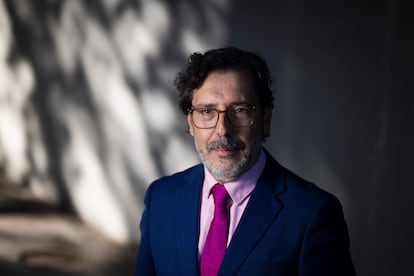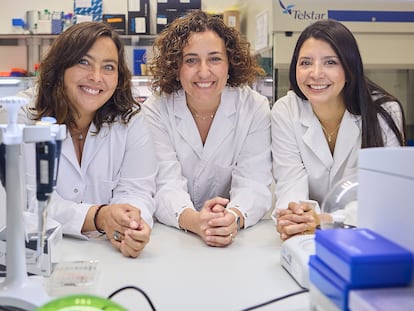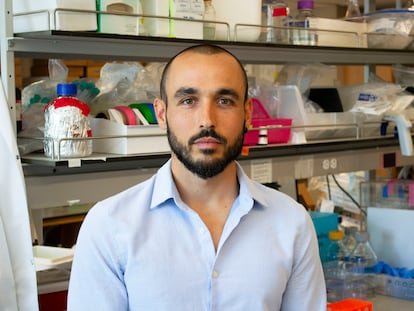César Rodríguez, oncologist: ‘Cancer is like a coup staged by your own cells’
The doctor points out that the great challenges in the fight against the disease are understanding the mechanisms of why some tumors resist treatment and why some patients do not respond to targeted therapies

You never know where life will take you. César Rodríguez was going to be a biologist, but ended up studying medicine. During his studies, he pursued his professional career away from patients, in the field of research and the laboratory — microbiology or biochemistry, perhaps — but he learned about clinical and healthcare medicine, and in the end settled on specializing in cardiology. That was his final decision until it wasn’t. “At the last minute,” during a random rotation through the oncology area, he discovered (with the help of his mentor, Dr. Juan Jesús Cruz) a discipline and a world he knew almost nothing about. It was 1993 and “cancer, at that time, was still a disease that was almost always fatal, and had very few treatment options. It was a speciality in which much work remained to be done,” explains the doctor, who is now an oncologist at the University Hospital of Salamanca (Spain).
Thirty years have passed since those first turns in life that, against all odds, led him to oncology. Although the study of cancer has taken a giant leap forward, it still remains an enigmatic disease, admits Rodríguez, who debuted as president of the Spanish Society of Medical Oncology (SEOM) at the society’s congress in Barcelona last week.
Question. You say that, when you started, it was a discipline in which much remained to be done. Now, 30 years later, has everything been done?
Answer. Much of what we thought was yet to be done has been done, especially in understanding tumors. But everything remains to be done because if we already knew everything we would be curing most of the tumors. What’s left to do now? Understanding the mechanisms of resistance to the treatments we use is probably one of the [most complex] challenges we have. Also, understanding why in some cases where we have very well-designed treatments to address a very specific therapeutic target, we still do not have uniform efficacy in all patients: what differentiates patients who do very well with a treatment from those who are not doing well? And then there are much more basic challenges: early diagnosis, the challenge of not having to treat but rather prevent at a social level continues to be a problem. We have not yet managed to reach the point where we diagnose tumors in the very early stages.
Q. Oncologist Siddharta Mukherjee said in an interview in EL PAÍS that cancer continues to be one of the greatest mysteries of medicine. What do you think?
A Cancer is one of the greatest mysteries of medicine because cancer is a revolution in your own body, it is like a coup d’état staged by your own cells. It is your own DNA, your own cells, your own identity that turns against you. They undergo certain modifications that make their behavior, which has always been to work with you and help you repair tissue when it is damaged, turn against you. The ones that cause you harm are the ones that have always helped your body solve problems, and they do it in a very well-prepared way. If cancer were simply a disordered proliferation of cells, it would never kill, and surgery would cure most tumors. Cancer is capable of growing, proliferating and, at a given moment, saying: “I am not satisfied with the problem I have created here and now I am going to look for ways to escape.” And these escape routes are much more complex than we believe. Not only is cancer capable of metastasizing (sending cells to other parts of the body), because if that were the problem, our immune system is quite smart and is able to identify what is foreign and would destroy it. Rather, it is able to escape and circumvent our immune system’s own recognition systems in a very intelligent way. That is, I grow, I proliferate, I escape, I am able to outwit [the immune system], and I proliferate again in territories that were not the most suitable for me. That’s what makes cancer such a difficult disease to understand. And it turns out that when you have already discovered the mechanism by which a tumor grows and you find a treatment strategy that can harm it, it is capable of developing resistance and ways to evade treatment.
Q. Is it survival instinct, in the end?
A. Yes, but in a very programmed way. The complexity of our own cells means that tumors also have these escape routes. For example, our cells are designed to be able to regenerate, and this ability to regenerate is what also makes tumor cells difficult to eradicate. And we also know that tumors have behaviors, growth, and proliferation mechanisms, that are so different from each other that we are talking about dozens of different diseases that have nothing to do with each other: there are breast cancers that are more similar to certain types of lung cancer when we analyze them from a genomic point of view.
Q. What do we not fully understand about cancer?
A. In many tumors, we know the mechanisms that lead to their development, but we do not know the primary cause. When we know that, we will have a much better understanding of everything that’s going on in the background. For some tumors we do know the cause: for cervical cancer it is infection by the human papillomavirus, and it has meant that, with vaccination programs, this tumor will be anecdotal in the developed world in the future.
Q. What if the cause is chance? A random mutation, for example.
A. When a change occurs that leads to the development of a tumor, generally speaking, something else has to go wrong. I once heard a teacher in a class in Salamanca say that we all get cancer every day, but we have mechanisms that prevent that from happening over and over again. These are mechanisms that, when a cell mutates or proliferates in an inappropriate way, lead that cell to a programmed cell death. There are also mechanisms that identify this proliferation as foreign so that your immune system can eliminate it. Under normal conditions, we are prepared so that all those alterations, those mutations that occur every day, do not get worse. The question is why in some cases this does not happen.
Q. Cancer has always been associated with aging and the forecast is that cancer numbers will rise because we are living longer. But tumors in young adults are also increasing. What’s going on?
A. You can never look for an explanation with a single factor. You always have to look for an accumulation of things. Fundamentally, this is happening in Western countries, where environmental factors and lifestyle habits related to the development of tumors have become more frequent: we are seeing a global population that is more overweight and has a diet that is not the most appropriate. Our our alcohol consumption is very high, we have a smoking habit that we are unable to quit, excess calories in our diet, a sedentary lifestyle, and so on. Exposure to environmental risks, such as pollution, is probably another factor. If you put all this together, it is logical to think that Western society is increasingly exposed to risk factors earlier in life, and so you will develop tumors sooner. And then there’s another factor: detection at a younger age is also sometimes linked to better diagnostic techniques.
Q. Regarding secondary prevention, in the presentation at the SEOM congress, you warned of the need to refine screening, including moving towards molecular screening. Where do you want to go [with that]?
A. We cannot do what is difficult before knowing how to do what is easy. Breast cancer screening, which cost a lot to make universal, is a reality, but there is still a way to go with colon cancer. Although it is true that, at a certain point, you have to realize that screening programs have to be aimed at the populations in which you can obtain health results: it is not feasible to do a CT scan on the entire population to look for any [type of] tumor, but we know that there is solid data that certain radiological studies in the smoking population will allow there to be less mortality from that cause. We will need to combine population screening programs, where we know that we can benefit a large population with a simple and affordable test, with more selective programs in at-risk populations.
Q. Last week a study was published on breast milk screening, during the postpartum period, to detect the DNA that causes breast cancer tumors. In the long term, will there be more refined screening, such as molecular testing?
A. The scientific community is convinced that molecular screening will be a reality. The ability to detect molecular alterations that indicate that there is a tumor and the origin of that tumor, technically, is already a feasible reality. But it must be refined. The study with breast milk samples is fantastic. Other examples are that, via blood testing, we can determine the DNA circulating in peripheral blood and identify certain molecular alterations. This will allow us to know if that person is at risk or is already incipiently developing a tumor. That will be an indisputable reality. What we don’t know is when we will be able to implement it.
Q. In the congress presentation you also mentioned tertiary prevention, in former cancer patients. What does that involve?
A. Today we know that, after having a tumor and being cured, there are certain behaviors that allow us to reduce the risk of relapse as much as (and sometimes more than) some treatment strategies do. That is, among women who have had breast cancer that has been properly treated: in the years following diagnosis and potentially curative treatment, there is a proportion that relapses. But we also know that, if these women are postmenopausal, are a normal weight and do well-scheduled physical exercise, eat a varied diet and do not consume alcohol, their risk of relapse is significantly lower.
Q. Regarding treatment, there has never been as much of a therapeutic arsenal as there is now. What’s missing?
A. We have a huge arsenal, and it is increasingly selective. What is needed now is to identify the populations that benefit from a specific therapeutic strategy. We still have very modern strategies in which, when we use them, we see that there is still a population that does not respond, despite the fact that they act on a specific molecular target.
Q. Can you give an example?
A. With immunotherapy we have been able to identify for some tumors, the most responsive patients are those who have an expression of a receptor that is PDL-1 or PD-1. But in certain types of tumor, such as triple-negative breast cancer, when we use it in neoadjuvant [before the main treatment], PDL-1 does not play a role in saying who responds and who does not, so it is given to everyone. Although we believe that we have very precise medicine, we have to continue refining the mechanisms that are able to identify which patients truly benefit from them, so as not to subject those who do not to treatment.
Q. People are still afraid of the word cancer.
A. There is still fear about the word cancer, but it has been greatly destigmatized. We have made a lot of progress in making cancer visible as something that is normal, but another thing is the stigma that cancer kills: there is still a long way to go. It is true that cancer continues to be a disease with a high mortality rate and as long as it has a high mortality rate, it will continue to be a disease that causes fear. There is only one option here: we have to continue improving therapeutic results and tell the population so that they understand that, whereas previously certain tumors had a poor prognosis, these can now be treated to allow patients to live with the disease and have a normal life.
Sign up for our weekly newsletter to get more English-language news coverage from EL PAÍS USA Edition
Tu suscripción se está usando en otro dispositivo
¿Quieres añadir otro usuario a tu suscripción?
Si continúas leyendo en este dispositivo, no se podrá leer en el otro.
FlechaTu suscripción se está usando en otro dispositivo y solo puedes acceder a EL PAÍS desde un dispositivo a la vez.
Si quieres compartir tu cuenta, cambia tu suscripción a la modalidad Premium, así podrás añadir otro usuario. Cada uno accederá con su propia cuenta de email, lo que os permitirá personalizar vuestra experiencia en EL PAÍS.
¿Tienes una suscripción de empresa? Accede aquí para contratar más cuentas.
En el caso de no saber quién está usando tu cuenta, te recomendamos cambiar tu contraseña aquí.
Si decides continuar compartiendo tu cuenta, este mensaje se mostrará en tu dispositivo y en el de la otra persona que está usando tu cuenta de forma indefinida, afectando a tu experiencia de lectura. Puedes consultar aquí los términos y condiciones de la suscripción digital.
More information
Archived In
Últimas noticias
Welcome to the post-religion era: The idea of Christianity as the absolute truth has become obsolete
‘I thought you would like it’: The risky sexual practice popularized by TV shows and TikTok
The digitalization of tourism: ‘They promise experiences and gave us the worst possible one’
Mexican peso defies uncertainty with forecasts of a new period of stability in 2026
Most viewed
- Sinaloa Cartel war is taking its toll on Los Chapitos
- Reinhard Genzel, Nobel laureate in physics: ‘One-minute videos will never give you the truth’
- Oona Chaplin: ‘I told James Cameron that I was living in a treehouse and starting a permaculture project with a friend’
- Why the price of coffee has skyrocketed: from Brazilian plantations to specialty coffee houses
- Silver prices are going crazy: This is what’s fueling the rally











































